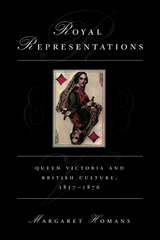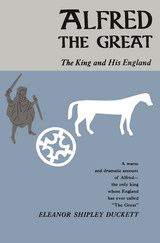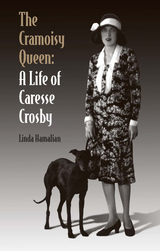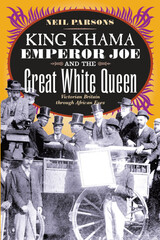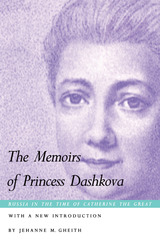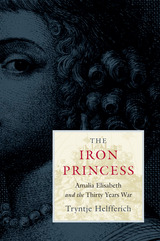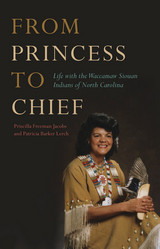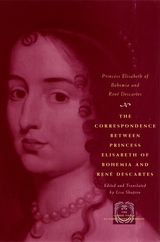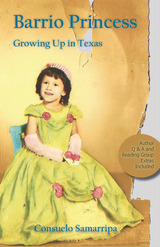The RoyalsCollection by Cassandra Verhaegen (10 items)A regal collection -- kings, queens, princesses, and princes. Includes the following tags:
1596-1650, 1894-1940, 1947-, Africans, Authors, Authors, Russian, Babelʹ, I. (Isaak), Biography & Autobiography, Bohemia, Court and courtiers, Cultural & Regional, Descartes, René, Descartes, Renâe, Growing Up, Jewish authors, King, Kings and rulers, Life, Literary Criticism, Mexican American women, Monarchy, North Carolina, Philosophy, Modern, Princesses, Royalty, Russia, San Antonio, Scholars, Social Science, Women's Studies
See More
|
Royal Representations
by Margaret Homans
University of Chicago Press, 1998
Queen Victoria was one of the most complex cultural productions of her age. In Royal Representations, Margaret Homans investigates the meanings Victoria held for her times, Victoria's own contributions to Victorian writing and art, and the cultural mechanisms through which her influence was felt. Arguing that being, seeming, and appearing were crucial to Victoria's "rule," Homans explores the variability of Victoria's agency and of its representations using a wide array of literary, historical, and visual sources. Along the way she shows how Victoria provided a deeply equivocal model for women's powers in and out of marriage, how Victoria's dramatic public withdrawal after Albert's death helped to ease the monarchy's transition to an entirely symbolic role, and how Victoria's literary self-representations influenced debates over political self-representation. Homans considers versions of Victoria in the work of Elizabeth Barrett Browning, George Eliot, John Ruskin, Margaret Oliphant, Lewis Carroll, Alfred Lord Tennyson, and Julia Margaret Cameron.
1
|
King of Odessa
by Robert A. Rosenstone
Northwestern University Press, 2007
An offbeat and brilliant imagining of a "lost novel" by Isaac Babel
A celebrated writer returns to his hometown of Odessa, pondering a deal with the secret police, pining for a daughter living abroad, and hoping to pen one last homage to his own past. Isaac Babel, the world famous spinner of tales about Cossacks and gangsters, arrives in Odessa to be treated for asthma-and perhaps help a condemned prisoner to escape. Or is it Babel who intends to escape? For six decades our only record of Babel's visit has been the contents of letters and postcards sent abroad to his mother and sister. In King of Odessa, Robert A. Rosenstone imagines a version of this visit and the novel Babel wrote during those weeks. Babel himself is concerned with more than literary plots as he considers an escape just as he starts an affair with an actress who may be a police spy. He also ruminates on his past-his childhood as a sickly Jewish boy, the horrifying 1905 pogrom, the famous rides with the Cossacks that inspired Red Calvary, and above all his complicated relationships with women. Throughout the novel Rosenstone captures Babel's lively wit, his exhaustion with fame and the Soviet system, and his infectious charm. This would prove to be Babel's last visit to Odessa. Three years later, he was arrested as a spy and executed. Rosenstone, the acclaimed biographer of writer and activist John Reed, mixes historical facts and fiction with the talent of a gifted storyteller. The result is a captivating exploration of a great writer surrounded by history and on the brink of falling out of it forever.
2
|
Alfred the Great
by Eleanor Shipley Duckett
University of Chicago Press, 1958
Filled with drama and action, here is the story of the ninth-century life and times of Alfred—warrior, conqueror, lawmaker, scholar, and the only king whom England has ever called "The Great." Based on up-to-date information on ninth-century history, geography, philosophy, literature, and social life, it vividly presents exciting views of Alfred in every stage of his long career and leaves the reader with a sharply-etched picture of the world of the Middle Ages.
3
|
The Cramoisy Queen
by Linda Hamalian
Southern Illinois University Press, 2009
Caresse Crosby rejected the culturally prescribed roles for women of her era and background in search of an independent, creative, and socially responsible life. Poet, memoirist, advocate of women’s rights and the peace movement, Crosby published and promoted modern writers and artists such as Hart Crane, Dorothy Parker, Salvador Dalí, and Romare Bearden. She also earned a place in the world of fashion by patenting one of the earliest versions of the brassiere. Behind her public success was a chaotic life: three marriages, two divorces, the suicide of her husband Harry Crosby, strained relationships with her children, and legal confrontations over efforts to establish a center for world peace. As the first biographer to consider both the literary and social contexts of Crosby’s life, Linda Hamalian details Crosby’s professional accomplishments and her personal struggles. The Cramoisy Queen: A Life of Caresse Crosby also measures the impact of small presses on modernist literature and draws connections between key writers and artists of the era. In addition to securing a place for Crosby in modern literary and cultural history, The Cramoisy Queen: A Life of Caresse Crosby contributes to the field of textual studies, specifically the complexities of integrating autobiography and correspondence into biography. Enhanced by thirty-two illustrations, the volume appeals to a wide range of readers, including literary critics, cultural historians, biographers, and gender studies specialists.
4
|
King Khama, Emperor Joe, and the Great White Queen
by Neil Parsons
University of Chicago Press, 1997
In 1895 three African chiefs, dressed in the finest British clothing available, began a tour of the British Isles. That tour foiled Cecil Rhodes' grand plan for Africa and culminated in the Chamberlain Settlement, the document that indirectly led to the independence of present-day Botswana. King Khama, Emperor Joe, and the Great White Queen is the story of this bizarre journey, one of the most neglected events in British Victorian history, here revealed for the first time in its full detail and cultural complexity. The chiefs initially went to England to persuade Queen Victoria not to give their lands to ruthless Rhodes and his British South Africa Company. Abandoned by the Secretary of State for the Colonies, Joseph Chamberlain, and denied an audience with the queen, the three rulers decided to tour the British Isles to plead their case to the populace. Appealing to the middle-class morality of Victorian society, the chiefs were remarkably successful in gaining support, eventually swaying Chamberlain into drafting the agreement that secured their territories against the encroachment of Rhodesia. Historian Neil Parsons has reconstructed this journey with the help of African archival materials and news clippings from British papers, garnered from the clippings service the chiefs had the foresight to employ. In equal parts narrative of pilgrimage, voyage of discovery, and colonial resistance, King Khama, Emperor Joe, and the Great White Queen provides a view from the other side of colonialism and imperialism. It demonstrates the nuances of cultural and religious interaction between Africans and Europeans, and it does so with the richness and depth of a fully realized novel.
5
|
The Memoirs of Princess Dashkova
by Ekaterina Romanovna Dashkova
translated by Kiril Fitzlyon Duke University Press, 1995
Ekaterina Romanovna Dashkova (1743–1810), Russian princess, playwright, author, President of the Academy of Sciences, and founder and Director of the Russian Academy, was one of the first women in Europe to hold public office. Her memoir, among the earliest examples of autobiography in Russia, is part of what has become a long and powerful tradition of autobiographical writing by Russian women. It offers a rare glimpse into the life of a strong and outspoken public figure who was well recognized in much of her own time for her potent intellect but who died in isolation and has largely been forgotten today. Originally written in French, first published in English, and long out of print, Dashkova’s Memoirs tell the story of a woman who at age eighteen played an important role in the coup that brought Catherine the Great to the throne. The relationship between these two women, often tense, is a central theme throughout this story. Dashkova, occupying the highly unusual position of both stateswoman and mother, also reveals her own path between the demands and limitations of the "private" and "public" spheres of her society. She provides a view of the expectations of Russian aristocratic women, the possibilities available to them, and the ways in which gender roles were conceived in the eighteenth century. With a new introduction by Jehanne M Gheith, The Memoirs of Princess Dashkova will renew interest in the life of a fascinating woman for students of Russian history, women’s studies, and eighteenth-century studies. It will be a significant text for those engaged in the cross-cultural study of the traditions of women’s autobiographical writing.
6
|
The Iron Princess
by Tryntje Helfferich
Harvard University Press, 2013
Thrust into power in the midst of the bloodiest conflict Europe had ever experienced, Amalia Elisabeth fought to save her country, her Calvinist church, and her children’s inheritance. Tryntje Helfferich’s vivid portrait reveals how this unique and embattled ruler used her diplomatic gifts to play the great powers of Europe against one another during the Thirty Years War, while raising one of the most powerful and effective fighting forces on the continent.
7
|
From Princess to Chief
by Priscilla Freeman Jacobs and Patricia Barker Lerch
introduction by Patricia Barker Lerch University of Alabama Press, 2013
A collaborative life history of Priscilla Freeman Jacobs, From Princess to Chief tells the story of the first female chief (from 1986 to 2005) of the state-recognized Waccamaw Siouan Indian Tribe of North Carolina.
In From Princess to Chief, Priscilla Freeman Jacobs and Patricia Barker Lerch detail Jacobs’s birth and childhood, coming of age, education, young adulthood, marriage and family, Indian activism, and spiritual life. Jacobs is descended from a family of Indian leaders whose activism dates back to the early twentieth century. Her ancestors pressured the local county and state governments to fund their Indian schools, led the drive for the Waccamaw Sioux to be recognized as Indians in state and federal legislation, and finally succeeded in opening the long-awaited Indian schools in the 1930s.
Jacobs’s lasting legacies to her community include the many initiatives on which she collaborated with her father, Clifton Freeman, including the acquisition of common land for the tribe, initiation of a tribal board of directors, incorporation of a development association, and the establishment of a day care and many other social and educational programs. In the 1970s Jacobs served on the North Carolina Commission of Indian Affairs and was active in the Coalition of Eastern Native Americans.
Introducing the powwow as a way for young people to learn about the traditions of Indian people throughout the state of North Carolina, Jacobs taught many children how to dance and wear Indian regalia with pride and dignity. Throughout her life, Jacobs has worked hard to preserve the traditional customs of her people and to teach others about the folk culture that shaped and molded her as a person.
Told from the point of view of an eyewitness to the community’s effort to win federal recognition in 1950 and their lives since, From Princess to Chief helps preserve the story of Jacobs’s Indian community.
8
|
The Correspondence between Princess Elisabeth of Bohemia and René Descartes
by Princess Elisabeth of Bohemia and René Descartes
translated by Lisa Shapiro University of Chicago Press, 2007
Between the years 1643 and 1649, Princess Elisabeth of Bohemia (1618–80) and René Descartes (1596–1650) exchanged fifty-eight letters—thirty-two from Descartes and twenty-six from Elisabeth. Their correspondence contains the only known extant philosophical writings by Elisabeth, revealing her mastery of metaphysics, analytic geometry, and moral philosophy, as well as her keen interest in natural philosophy. The letters are essential reading for anyone interested in Descartes’s philosophy, in particular his account of the human being as a union of mind and body, as well as his ethics. They also provide a unique insight into the character of their authors and the way ideas develop through intellectual collaboration.
9
|
Barrio Princess
by Consuelo Samarripa
Parkhurst Brothers, Inc., 2014
"Made in Mexico, born in America," Barrio Princess shares heartwarming family stories, cultural tradition stories, learning English by total immersion, socialization as a minority, education, stories of her mother as a single parent, and women’s stories from a minority point of view.
10
|
| Click here to go to the beginning. | ||||||||||
